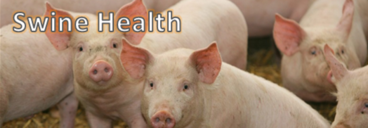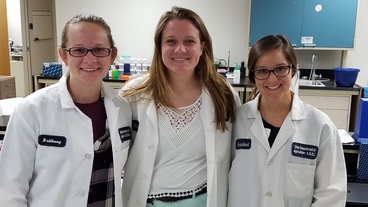 ADDL Provides Same Day Testing for Influenza in Swine
Dr. Beverly Byrum, PhD, DVM, ADDL Laboratory Director
Melanie Prarat, MS, ADDL Virology Section
Influenza is a respiratory disease caused by type A
influenza viruses that regularly cause outbreaks in pigs. Influenza is present
at low levels in pigs throughout the world, and is monitored by the voluntary
USDA Swine Influenza Surveillance Program, although it is not a reportable or
regulated disease.
Like human influenza viruses, there are different
subtypes and strains of influenza viruses in pigs. The main influenza viruses
circulating in U.S. pigs in recent years are H1N1, H1N2 and H3N2. While H1N1
viruses have been known to circulate among pig populations since at least 1930,
H3N2 and H1N2 influenza A viruses did not begin circulating among pigs in the
United States until about 1998.
While
influenza viruses almost always remain infectious only within their host
species, at times infections may spread to other species. Influenza viruses in
pigs can occasionally infect people, and human influenza viruses can infect
swine. Health organizations use the term "variant" to refer to
viruses that are genetically different from what is usually isolated from
humans. The description is written as a small "v" after the virus
subtype, for example, H3N2v. More information on these variant viruses is
available from the U.S. Centers for Disease Control at http://www.cdc.gov/flu/swineflu/.
The ADDL offers same day PCR test results for influenza A samples from swine. Samples arriving in the laboratory by 11 AM will be reported by 5 PM. Recommended samples are nasal swabs transported in BHI, viral transport media, or sterile solution (3-5 cc). Samples should be shipped on ice overnight or delivered to the laboratory by courier. Call the ADDL at 614-728-6220 if you have any questions.
 Update: West Nile Virus Found in Ohio Mosquitoes
Dr. Jeff Hayes, MS, DVM, ADDL Pathology Section Head
There is an increased incidence of West Nile Virus (WNV)-positive mosquitoes throughout Ohio this summer. As
of July 10, 2017, the Ohio Department of Health Zoonotic Disease Program has already identified 25
WNV-positive mosquito samples in 6 Ohio counties (Franklin - 10, Lorain -2,
Lucas - 4, Montgomery -1, Richland -1, and Summit - 7) (see full report here).
The ADDL supports veterinarians’ efforts to recommend
vaccination of clients’ horses against WNV, a preventable disease
that unfortunately can prove to be fatal in unvaccinated animals. Horses that have been vaccinated in past
years will need an annual booster shot. However, if an owner did not vaccinate
their animal in previous years, the horse will need the 2-shot vaccination
series within a 3- to 6-week period. The peak season of WNV equine infections
in Ohio is rapidly approaching (August, September), so there is still time to
vaccinate!
The Ohio
ADDL can facilitate serologic testing at NVSL, and has PCR testing capability
of blood and tissues, also. Contact the ADDL at 614-728-6220 with any questions
regarding WNV testing by serology, PCR, necropsy, and histopathology.
 Harmful Algal Blooms
Dr. Diane Gerken, DVM, PhD, Professor Emeritus, Ohio State University
Blue-green algae blooms, or more
correctly referred to as cyanobacterial blooms, in ponds, lakes and standing
water are occurring in Ohio again this year which means the potential for
serious health effects in large/small animals, wildlife
and humans. Certain cyanobacteria have
the potential to produce intracellular toxins –microcystins (a group of similar
structured substances) and anatoxins (A being only one of the two types). Ingestion of microcystins have
been reported to result in severe liver disease (clinical signs include
lethargy, vomiting, diarrhea, weakness and pale mucous membranes) and sometimes death. Anatoxin A ingestion results in
central nervous system effects (clinical signs include muscle tremors, rigidity,
lethargy, respiratory distress and convulsions). Water (or water
rinse of obvious hair coat contamination) and gastrointestinal contents (or
rumen contents) can be analyzed for microcystins or anatoxin A by submitting
the above specimens or whole animal submission for necropsy to the ODA ADDL
Pathology Section.
Microcystins are stable for days to weeks in
water. Waters treated with algaecides
have the potential to contain more free toxins in the water and therefore are
more hazardous. Whether it is a pet or farm animal that is affected, a positive
diagnosis via chemical analyses is recommended to verify the cause and to
determine the source as soon as possible. If animal exposure to public water
was a possible source, please notify the responsible public health official or
the Ohio Department of Health. If
suspected exposure may have been in a backyard or farm pond on private property,
submit a water sample to the ODA ADDL Pathology Section. More information and
methodologies for detection can be found at the Ohio Environmental Protection Agency Harmful Algal Blooms website.
 Comparison of water without (left) and with (right) blue-green algae present.
Summer Students at ADDL
Melanie Prarat, MS, ADDL Virology Section
The ADDL hosts interns throughout the year in each laboratory section. The Virology section hosted three exceptional interns this summer. Andrea Lohr and Darien Gordon are both pre-veterinary medicine undergraduates at Findlay University, and Daysha Wells is a current MPH student who will be attending veterinary school at the Ohio State University this fall. At ADDL, each intern worked at assigned testing areas and was also introduced to other sections including veterinary molecular diagnostics, virology, serology, pathology, and bacteriology.
 Left to Right: Andrea Lohr, Darien Gordon, Daysha Wells
|